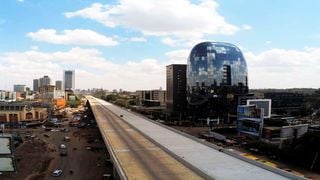
An aerial view of the Nairobi Expressway along Waiyaki Way on November 12, 2021.
| Jeff Angote | Nation Media GroupNairobi
Premium
Road transforming the capital’s skyline
Nairobi is renowned for its mix of historic and modern architecture to create a skyline that is dynamic and awe-inspiring.
Head up to any top building along Uhuru Highway and you will see with a clear view the now almost complete Nairobi Expressway, which has, in less than two years, changed the look of the capital city.
Nairobi was created out of a series of small villages that morphed into a large metropolis.
According to Transport Cabinet Secretary James Macharia the partially elevated 27-kilometre highway from Mlolongo through Uhuru Highway to the James Gichuru Road junction in Westlands that was initially to be completed in December 2022 but was speeded up to December 2021 is currently 75 per cent complete.
“Almost all closed sections along Mombasa Road have already been partially opened to ease traffic jams,” the CS said.
Kenyans will pay toll charges to use the road, whose construction will ensure “seamless flow of traffic”, among other economic benefits, according to the CS.
Motorists using Uhuru Highway and Mombasa Road have been forced to use alternative routes as construction work continues to create traffic snarl-ups.
China Road and Bridge Corporation (CRBC), who are financing and building the expressway, will also repair the road. According to the CS, the Sh72 billion budget for the entire project will also be used to repair the three roads, which are in a deplorable condition.
Traffic gridlock
“During construction, the old road was damaged as the contractor had to do piling. But the contractor will restore the old road and leave it better than they found it,” Mr Macharia said.

The expressway is changing the city’s skyline.
Construction started last year and has come at a high cost for businesses and residents on Mombasa Road, with motorists enduring traffic constant traffic gridlock.
The dual carriageway will have 10 interchanges, including the standard gauge railway terminus at the Jomo Kenyatta International Airport, Eastern Bypass, Southern Bypass and Enterprise Road.
“By December, we will be able to test-drive from Nextgen Mall through the city centre to St Marks Church, covering 8.2 kilometres.
We’re happy with the progress and test runs on the road will take place in March next year as we are confident that the contractors will have completed all works by February,” he said.
Kenyans will be expected to pay between Sh100 and Sh1,550 in toll charges, depending on the size of the vehicle and the distance covered.

Nairobi Expressway along Waiyaki Way and Uhuru Highway on November 12, 2021.
The expressway is a four-lane and six-lane dual carriageway within the existing median of Mombasa Road-Uhuru Highway-Waiyaki Way. President Kenyatta launched it in October 2019 and it’s expected to be completed and opened for traffic early next year.
“The Nairobi Expressway is the first public-private partnership road project in Kenya. The concessionaire [CRBC] is responsible for designing, financing and building the expressway, and will maintain and operate it during the concession period,” he said.
Moja Expressway, a subsidiary of CRBC, will operate the road for 27 years to recoup funds through toll fees.





